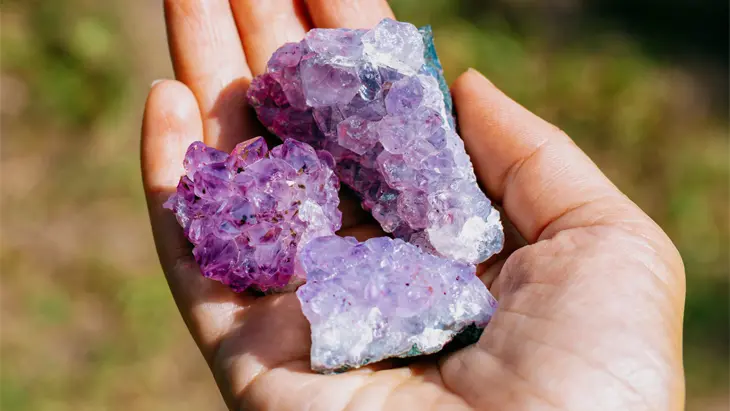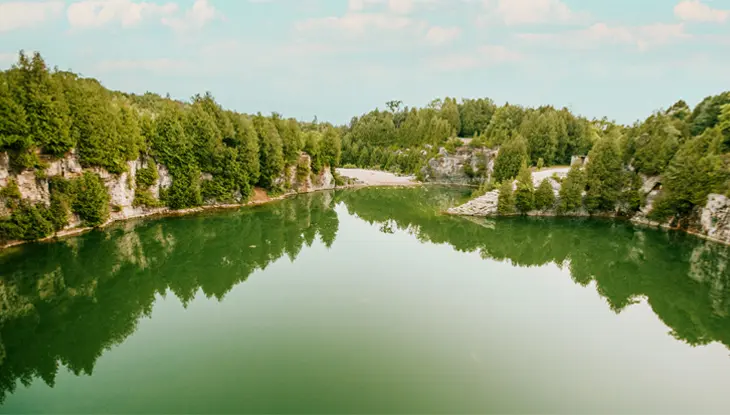Rockhounding in Ontario

Rockhounding is the term for recreational or hobby mineral, rock and gemstone mining and collecting. Rockhounds can turn up specimens in their backyards or travel the world looking for a new addition to their collection.
Ontario is home to several rockhounding hotspots with the potential to uncover a new rock or mineral specimen on your wish list.
Please note that you should obtain permission to access sites located on private property. Items in your kit could include:
- first aid kit and bug spray
- long sleeve shirt, long pants, rain gear, protective gloves and safety boots
- backpack, flashlight and headlamp
- a small shovel, a rock hammer and/or a chisel, a penknife, brushes and a pry bar
- safety glasses or goggles
- local topography maps and a compass
- notebook and pencils
- container/fabric bags to store samples and specimens
- route planning
Here’s a list of places to go rockhounding in Ontario.
Haliburton Highlands to the Ottawa Valley
Bancroft
Located in Hastings County, the area around the town of Bancroft is renowned for rockhounding. Part of the Canadian Shield, this area is 1.1 to 1.8 billion years old.
Mining activities began in the late 1800s, but the veins found were small. Unlike other areas in the province, the mines temporarily closed, until the uranium boom in the late 1950s, when three mines reopened. However once again the finds were small, and with mining costs high, industrial mining ended. But the area has grown into a rockhounding mecca for fools’ gold, mica, apatite, rose quartz and white quartz. In fact, Bancroft has been coined the "Mineral Capital of Canada."
Rockhounding highlights around Bancroft include:
Miners' Loop
This driving tour includes Millside Park, Hastings Trail, Deloro Mine Site and the Marmoraton Mine site.
Bonnechere Museum and Geoheritage Trail
Known as the "Ordovician Fossil Capital of Canada," this live museum explores the natural and cultural history along the Bonnechere River and provides guided tours and fossil hunts.
CN Rock Pile
Located along the Hastings Heritage Trail and across from the Bancroft Municipal Office, this site contains materials from the Golden-Keene Quarry used during the construction of the railway. Rockhounding here is free.
Princess Sodalite Mine Rock Shop
Uncover treasures at this "rock farm", chat with rockhounding expert Andy Christie, and browse minerals and sodalite, which he mines on site.
Lakeside Gems
Stock up on all the rockhounding tools you’ll need and admire an impressive collection of local and international minerals and semi-precious gemstones. Sign up for a geologist-led collecting field trip or book a private group experience.
Eagles Nest Lookout
A local must-see, this lookout atop a 60-metre rock wall provides an amazing view of Bancroft below.
Bancroft Rockhound Gemboree
Each year in July is the Bancroft Rockhound Gemboree, an event attended by over 100 dealers from across the globe to showcase their gem and mineral specimens and other treasures at the North Hastings Community Centre and the Bancroft Curling Club. You’ll also enjoy field trips, demonstrations and workshops.
Rockhounding Tours with Yours Outdoors
Join fellow rockhounders on a half-day or full-day guided tour with a local collector in Haliburton County, just west of Bancroft.
Fun fact: marble was also mined in this area at the Tatlock Quarry among others, the high-quality marble was used in the parliament buildings in both Ottawa and Toronto.
Dark Star Crystal Mines
Join Dark Star Crystal Mines to learn the art of crystal mining and set out on a dig in Monmouth County, just west of Bancroft. The mine operates seasonally, with weekend-only hours.
Northeastern Ontario
From Sudbury to Timmins to Cobalt, Northeastern Ontario has a wealth of rockhounding experiences. The area is home to both active and abandoned mines, as well as fantastic museums that tell the story of mineral history in this area and great rockhounding driving tours.
Rockhounding highlights in Northeastern Ontario include:
Sudbury
Almost two billion years ago, a massive meteorite created the second largest impact crater on earth, resulting in rich nickel copper ore deposits. The crater is 62 kilometres long, 30 kilometres wide and 15 kilometres deep!
This place is the Sudbury Basin, home of the largest concentration of mines in the world. By 1910, the Sudbury area was producing 80% of the world’s nickel. The Greater Sudbury city centre lies just south of what remains of the crater.
Dynamic Earth and Science North
Explore the tunnels and learn about mining in this area at this museum.
A.Y. Jackson Lookout
The route to this famous lookout crosses the ancient crater.
Sudbury Mining Camp
Visit the discovery site of Sudbury’s first mining camp on Regional Road 35, about five kilometres northwest of Greater Sudbury's city centre.
Mining Heritage Tour, Kirkland Lake
Learn about the mining history in Kirkland Lake along the “Mile of Gold," a line of seven major mines.
Jane Goodall Reclamation Trail
In the years since its mining heydays, the City of Greater Sudbury has undergone environmental restoration of many of the landscapes damaged by mining as part of a Regreening Program. The Jane Goodall Reclamation Trail provides a self-guided tour of one such reclamation and healing site.
Cobalt Mining Museum
View the largest display of silver at the Cobalt Mining Museum.
Heritage Silver Trail
Established by the Cobalt Heritage Society, this self-guided tour leads to several silver mines and mill sites in the Cobalt area.
Copper Cliff Smelter Superstack
Follow a GeoTour for a close-up view of this massive iconic chimney that defines the Sudbury skyline from the historic neighbourhood of Copper Cliff.
Temiskaming Shores
Tour the distinctive and out-of-place landscapes of the “Little Clay Belt” in the towns of New Liskeard and Haileybury and learn about its unique geology.
Killarney
About an hour and a half drive from Sudbury, the village of Killarney is perched on the rocky shores of Georgian Bay. Tour the surrounding landscapes of white-capped mountains, clear waters and pink granite rocks that illuminate at dusk and dawn and learn about the area’s geological origins.
French River Provincial Park
The Visitor Centre at this park, located between Parry Sound and the city of Greater Sudbury, highlights the history, geology and ecology of this famous waterway. Trails and a suspension bridge provide striking views of the river’s rock-walled gorge.
Timmins
One of the richest goldfields in the world, Timmins has produced more gold than any mining camp in Canada over the past century. This GeoTour highlights Timmins’ “Big Three” gold mines—Hollinger, Dome and McIntyre—as well as city parks reclaimed from former mine sites.
Gowganda and Matachewan
These rural communities in the Temiskaming District have several abandoned silver mines and silver arsenide-related minerals nearby. The barite mines are known to have calcite, fluorite, pyrite and some rare finds of copper, within the rock dumps.
Sault Ste. Marie and Algoma
Algoma Country
Explore the mining history and geological story of Elliot Lake, Bruce Mines, St. Joseph Island and along the shores of the majestic Lake Superior.
Rockhounding highlights in Algoma Country include:
Elliot Lake
Referred to as the uranium capital of the world, ten mines began production between 1955 and 1960 in the Elliot Lake area and operated until the 1990s. There are hundreds of kilometres of ore stopes in the now-closed Denison uranium mine. The Miners Memorial Park commemorates workers who have lost lives due to mining accidents and occupational illnesses.
Bruce Mines
Bruce Mines was the first successful copper mine in Canada. Guided summer tours are available at the Simpson Mine Shaft which has been restored to demonstrate copper mining in the mid 1800s. This area is the boundary of the Canadian Shield and the Great Lakes Lowlands and provides multiple opportunities to search out various minerals and rocks. Commonly found minerals include chalcopyrite, bornite, azurite, jasper, uraninite and calcite crystals. It is rumoured there are even traces of gold in the old mine near Ophir.
Desbarats
Puddingstone in this area can be found all along the shores of Lake Huron and ripple rock sandstone formations can be found along Highway 17 west of Desbarats and Highway 638.
St. Joseph Island
On St. Joseph Island there are plentiful limestone deposits where you’ll find fossils from brachiopods to trilobites.
Lake Superior Provincial Park
Famous for its great beauty along the coastline, this park offers a driving tour on the shores of the largest freshwater lake in the world, Lake Superior. Even the colourful sand itself is made of grains of so many different rocks and minerals.
Northwest Ontario
Superior Country
This region is home to the largest Amethyst deposit in all of Canada.
Rockhounding highlights in Superior Country include:
Amethyst Mine Panorama
Just 60 kilometres east of Thunder Bay, this mine has been operating for over 35 years by a local family. Amethyst is a beautiful violet variety of quartz that the ancient Greeks used to improve intelligence. Today, amethyst is used in jewellery. Your adventure begins at a beautiful welcome centre and continues to the picking and digging area. Guided tours are available and historical panels share interesting tidbits of mining in this area.
Diamond Willow Amethyst Mine
From May to October, visitors are invited to collect many types of amethyst on a self-guided tour at this family-owned and operated open pit Amethyst Mine. There’s also the Amethyst Country Rock & Gift Shop to purchase beautiful and colourful amethyst specimens and other unique gifts.
Nipigon
Another great GeoTour highlights nine well-known geological sites that illustrate this unique geology and geography around the town of Nipigon, such as towering cliffs and distinctive red rocks.
Whether you’re a veteran or beginner, recreational rockhounding is a fun and educational way to explore Ontario. Happy hounding!
Related content
Last updated: December 15, 2025


